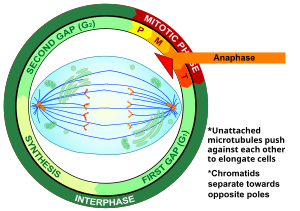Anaphase
Anaphase, from the Greek ανα (up) and φασις (phase), is a phase of mitosis and meiosis in a eukaryotic cell, in which the duplicated chromosomes are separated. The chromatids are then moved to opposite poles of the dividing cell by the mitotic or meiotic spindle, so that each daughter cell inherits one copy of each chromosome. Anaphase is also when the chromosomes reach their maximum level of condensation.
Mitosis
At the beginning of anaphase the sister chromatids are totally separated and directed towards opposite poles of the dividing cell. The main point of contact of the microtubules with each chromosome is a protein complex called a kinetochore, which is assembled on each centromere. Those microtubules that contact the kinetochore are called K fibers.
Anaphase begins with protein regulation of the metaphase-anaphase transition. At this point, the anaphase promoter complex (APC) is activated, metaphase ends when the cyclin necessary for its operation is deactivated (cyclins dependent on kinase M-CDK). Securin, a protease inhibitor protein known as separase, is also inactivated. The separase can then cut cohesin, the protein responsible for keeping the two chromatids together, and this is the point at which anaphase is considered to have begun.
Within anaphase two processes take place. During early anaphase the chromatids separate due to the shortening of the microtubules and thanks to the kinetochores. When the chromatids are completely separated, late anaphase begins, in which the microtubules are shortened to direct each group of chromatids towards opposite poles of the cell. This is also the time when the chromosomes reach their maximum condensation point, which contributes to their segregation and the formation of new nuclei.
Meiosis
During Meiosis, two processes of division of the nucleus occur: Meiosis I and Meiosis II. Meiosis I is divided into Prophase I, Metaphase I, Anaphase I, and Telophase I. Meiosis II is divided into Prophase II, Metaphase II, Anaphase II, and Telophase II.
In Anaphase I, the centromeres begin to separate, attracted by the poles, and each one drags in its movement the two chromatids that are attached to it. Pairs of homologous or bivalent chromosomes in which there are no chiasmata or are only terminal, simply separate, but if there are interstitial chiasmata, they slide towards the chromosome ends. Between the centromere and the first point of the diplotenic chiasm, the paternal and maternal chromosomes separate, but between this chiasm and the next, sister chromatids separate. The force of attraction between the paired chromatidia disappears. Paternal and maternal centromeres are randomly distributed to the two poles of the spindle.
Anaphase II is similar to that of mitosis, the daughter centromeres separating, attracted towards the poles, and dragging the chromatids in their movement.
- or
Contenido relacionado
Testicle
Essential chemical element
Neck
